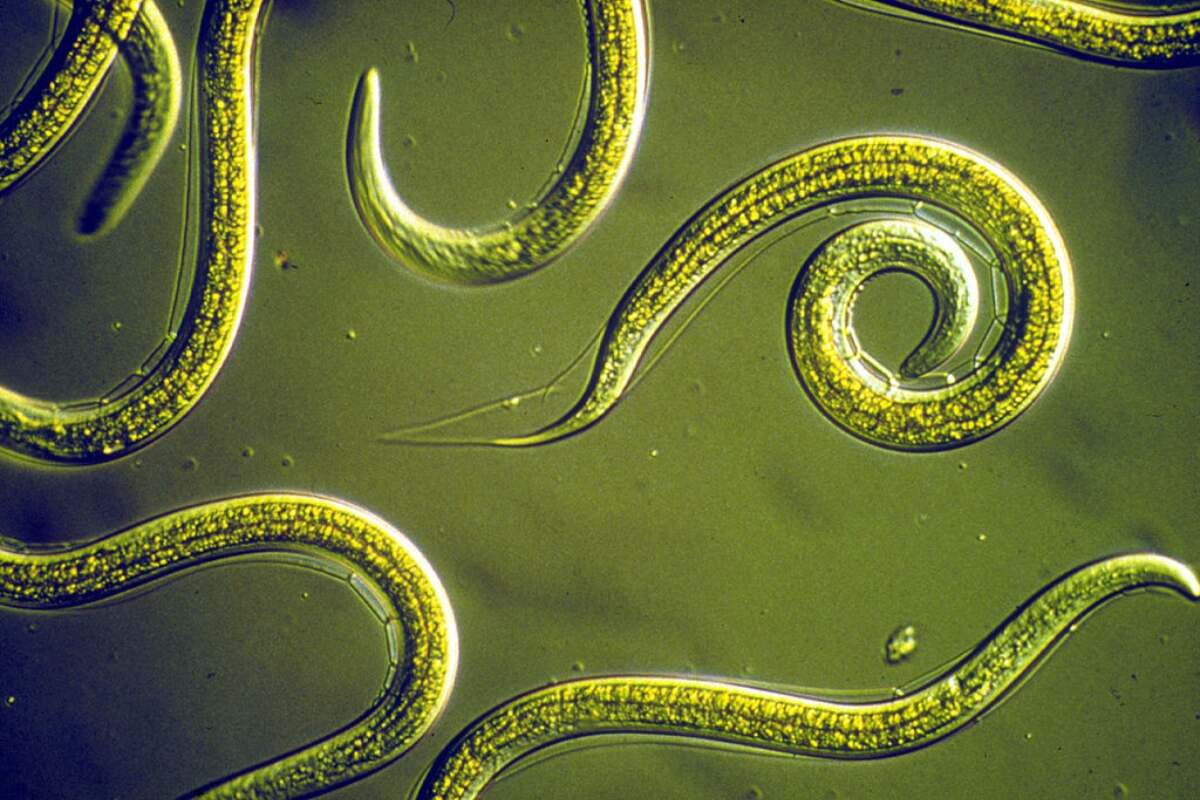
Many gardeners and lawn owners wonder about this miracle organic pest control solution: beneficial nematodes. Where can you buy them? How do you use them? How do they work? Are they working at all?
Less familiar to the average Joe, beneficial nematodes have been used for biological pest control for decades with excellent results. They are microscopic organisms that infest and kill various pests, such as nasty western flower thrips, mole crickets, and fungus gnats.
But fear not. Beneficial nematodes are perfectly safe for humans, pets, and beneficial insects and won’t harm your plants or the environment. You can use them on your lawn, vegetable garden, flower beds, greenhouse, or corn field.
Let’s get to know these helpful parasites better and learn how to use their peculiar abilities to keep your plants safe.
What are Beneficial Nematodes?
Beneficial nematodes are microscopic organisms, 0.02 to 0.06 inches long. As you might guess, you can’t see them with the naked eye.
Through a magnifying glass, they look like narrow, long worms with transparent, smooth, threadlike bodies, turning and twisting in curved shapes.
They feed on insect pests and are ultra-efficient organic pest control agents. Also known as “roundworms” and “entomopathogenic nematodes” (or EPNs), meaning insect-parasitic nematodes, beneficial nematodes might be the best organic solution for your lawn or garden pest problem.
Scientists have been studying them for quite a while. They have been used in biological pest control since 1930, while the first commercially available product was made in 1981 at “The Nematode Farm” in Berkeley.
Today, their popularity is skyrocketing due to the increasing interest in organic farming, chemical-free gardening, and eco-friendly lawn care.
Parasitic nematodes are used extensively across America to control over 200 species of nasty pests. Have you tested their skill? They are easy to find in online shops and local garden stores.
Where to Buy Beneficial Nematodes
You can buy beneficial nematodes for pest control from local nurseries, retail stores such as Amazon and Walmart, and specialized e-shops like:
They are sold under brands such as NemaShield, NemAttack, Nemasys, Scanmask, and Entonem. The most common forms are granules, gel, clay, and moist sponges.
Beneficial nematodes are sealed in plastic envelopes and trays to keep them moist and alive. Depending on the area you’re treating, you can choose between packages with 5, 10, 25, 50, and 100 million nematodes.
Here are a few examples of popular products:
Pro tip on buying beneficial nematodes: Only buy the amount you need to apply. Beneficial nematodes have a short lifespan of 2 to 4 weeks if kept in the refrigerator.
How to Use Beneficial Nematodes
When using parasitic nematodes, remember you’re working with live organisms. They require certain conditions to survive and do their job effectively. This guide takes you through the process step by step, so keep reading to learn how to use beneficial nematodes with the best results possible.
Receiving and Storing
It’s a beautiful morning, and you’re enjoying a delicious coffee when the doorbell rings. It’s the courier with your precious nematodes! What do you do now?
Open the Package Immediately
Nematodes must be kept in a cold environment, at 40°F, until application. They usually travel with an overnight courier in an isolated box retrofitted with cold packs.
Once you take that box in your hands, there’s no time to waste. Leave the coffee on the table and take care of your valuable pest terminators:
- Open the package immediately upon receiving it.
- Check if the inside of the box is still cold and if the ice packs are frozen.
- Check the nematode bags or trays inside. A uniform, light brown color, similar to yeast, without stained material in the corners, is what you’re looking for.
Store in a Dedicated Fridge
Put the nematode box into the refrigerator immediately and keep them cold, at 40°F, until use. If possible, keep it in a dedicated fridge, such as the fridge in your garage that stays mostly empty.
Opening the door repeatedly to take out your favorite snacks during the day can compromise the temperature and the nematodes.
Also, don’t freeze the little buggers. You’re dealing with live beings, and they die if frozen.
You can keep the package in the fridge for 2 to 4 weeks if unopened. Don’t postpone the application too much if you want good results.
The Best Time to Apply Nematodes

Generally, the best time of the year for nematodes to control pests is spring or fall. This is when most pests dwell in the soil in their larvae or pupae stage and are the most vulnerable to nematode attack.
The best time of day for application is as early in the morning as possible. Nematodes can be harmed by UV radiation and desiccation, so you’re looking for a period with soft light and mild temperatures to set them free.
Late in the evening is another good option, but comes with the risk of fungal diseases. You use water to spread the nematodes, and plants and grass will stay wet overnight if watered in the evening.
Experts recommend application when the topsoil layer is between 52 and 87°F. S. feltiae, the species of nematode most sensitive to heat, can tolerate 90°F only for a couple of hours.
Hot soil is not much of a problem in North America. But, it might be an issue in the extreme south, in states like California, Florida, and Texas.
Use a thermometer to measure the soil temperature before application. Also, keep an eye on the weather forecast to see what’s coming.
Shop soil thermometers online:
Protective Equipment
You don’t need any protective equipment when working with beneficial nematodes. They are safe for humans, pets, plants, and insects other than their target pests. So safe that they are exempt from registration by the EPA.
How Many Nematodes Do You Need?
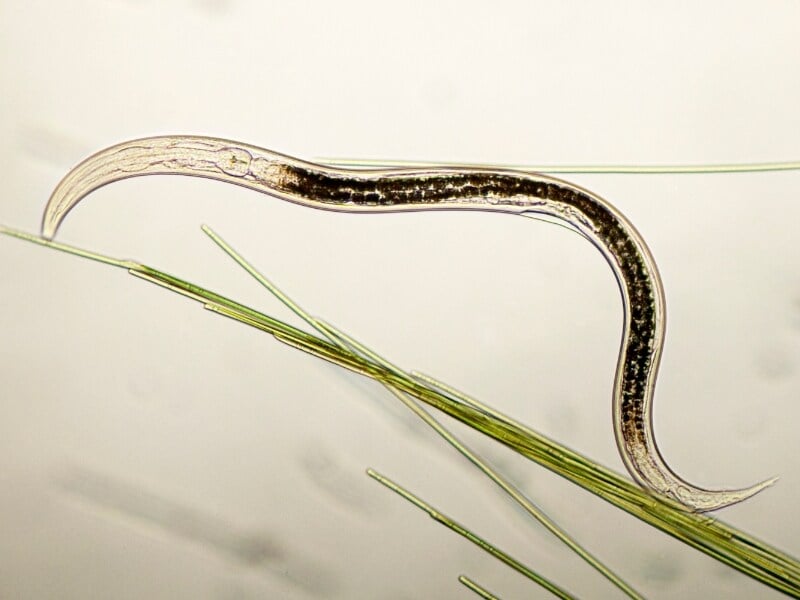
The amount of nematodes depends on the product you buy. For example, BioLogic recommends 5 million nematodes for a 200-square-foot area and 25 million nematodes for 1,000 square feet.
Nature’s Good Guys recommend applying their Triple Blend Mix with 5 million nematodes on up to 1,250 square feet.
The quantity also depends on treatment frequency. If you apply nematodes every 1 or 2 weeks, you can use fewer nematodes per treatment. You need more concentrated applications if you only spread nematodes once every 4 to 6 weeks.
How to Prepare the Nematode Solution
Suzanne Wainwright-Evans, a horticultural entomologist specializing in integrated pest management, says, “Think of your nematodes like goldfish,” meaning:
- Don’t keep them in the sun. Intense UV light can kill nematodes in half an hour.
- Don’t throw the nematodes from the fridge directly into the water. Let the package stay at room temperature for at least half an hour to acclimate.
- Aerate the water mix. Nematodes need oxygen like fish. For small applications, it’s enough to stir the liquid frequently. A fish bubbler or other aeration system can be used for larger amounts.
Check the product instructions to see how much solution you need and at what concentration. The typical nematode-to-water rate is 100 million:1 gallon. For example, in 5 gallons of water, you add 500 million nematodes. Or, if you’re covering a small garden area, you might only use 0.25 gallons (about 32 oz) of water mixed with 25 million nematodes.
Prepare the solution following the next steps:
Step 1: Add a few inches of water into the bucket.
Step 2: Break the tray or bag sealing.
Step 3: Throw in the nematodes (if you opened a sealed bag or tray, it is best to use it all). Stir to homogenize the solution.
Step 4: Test the nematodes. Put a small amount of liquid from the bucket on a glass or plastic tray or a petri dish. Look at the sample with a dissecting microscope, a small lens attached to a standard smartphone, or a simple hand lens.
If nematodes are moving, shaped as curved letters (Cs, Gs, Ss), they are alive and ready for application. Unmoving, arrow-shaped nematodes are dead and will not have any effect on pests.
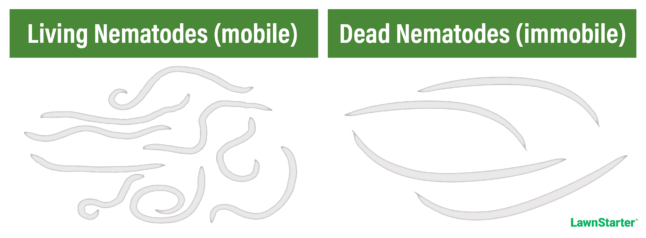
Step 5: Add the rest of the water and stir again.
Step 6: Put the liquid into your device to spread the nematodes. You can use:
- Watering can
- Hose-end sprayer
- Handheld or backpack pump sprayer
- Miracle-Gro sprayer
- Injector
- Boom sprayer
Shop microscopes or magnifying lenses online:
How to Apply Nematodes
Working with nematodes requires some preparation. Here’s how to correctly take nematodes from a bucket to their hunting ground in five easy steps.
Step 1: Prepare the tools. Flush the spreading device of all chemical substances. Remove filter screens with a mesh size smaller than 30. They can damage the nematodes. Ensure a water pressure of less than 300 psi to avoid hurting the microorganisms.
Step 2: Irrigate the soil before application. Nematodes travel through the ground using water, so ensure the soil is moist before application. If the soil is compacted, consider aerating the lawn to create space for water and nematodes to travel through. Now, you’re all set to begin the application!
Step 3: Spread the liquid close to the soil surface. Apply enough to moisten the topsoil but not so much as to lose the solution through runoff. With dense canopy plants and thick lawns, ensure the liquid flows from the foliage toward the soil.
Step 4: Agitate the solution periodically to keep it aerated and ensure a uniform dispersal of nematodes.
Step 5: Water softly after application. Keep watering every 3 to 4 days to keep the soil moist if it’s not raining.
Pro tip: If you’re targeting pests with a foliar larvae stage, apply the nematodes on leaves at dusk. Or use shade covers to keep UV radiation and heat away. Also, consider organic alternatives more suitable for application on leaves such as diatomaceous earth.
How Nematodes Kill Pest Insects
Nematodes’ killing method is simple. They enter the host insect body through any orifice (mouth, anus, or spiracles – breathing holes). They release bacteria that kills the host and breaks down its tissue.
You might say this bacteria marinates the host insect for the nematodes because these little fellows use the dead insect body as a food source and a cozy home.
Beneficial nematodes go through six stages during their life cycle:
- The egg stage
- Four larval stages
- The adult stage
It’s their third larval stage when nematodes get to travel freely through the soil. They get the fancy name of “infective juveniles” and actively pursue host insect pests.
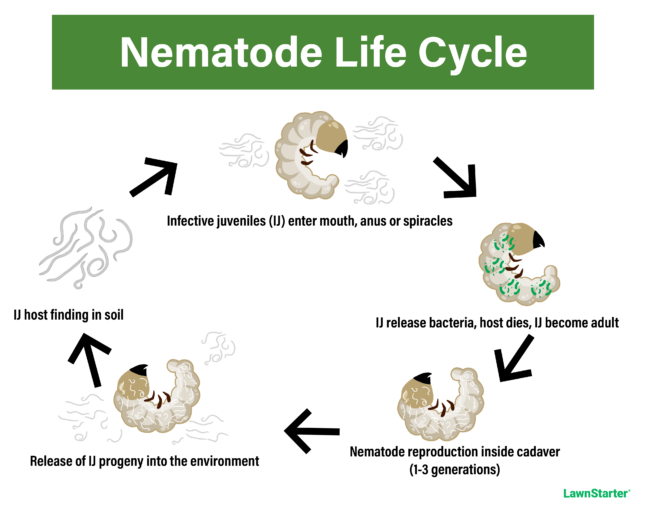
Infective juveniles board the host, infect it with deadly bacteria, feed, grow into adulthood, mate, make babies, and create up to three generations inside the pest insect. Their children, grandchildren, and great-grandchildren leave the host as infective juveniles and search for their next prey. So, with nematodes, you get an effective self-multiplying pesticide.
Infested host insects die in 24 to 48 hours.
How to Check for Results After Nematode Application
Since host insects take up to 48 hours to die, you won’t see them dropping dead on the soil, as sometimes happens with synthetic pesticides. There are two ways to check how effective the nematodes are:
1. Check the soil for dead larvae
Scratch the topsoil a little to look for dead insect larvae. Those killed by the Steinernema family of nematodes turn cream to dark brown, while victims of Heterorhabditis nematodes turn orange-red.
2. Use Sticky Traps
Another way to check the pest populations is with sticky traps:
- Put colored sticky traps across the treated area.
- Check and replace periodically.
With a successful application, you’ll see fewer and fewer captured insects on your colored traps. An accessible DIY alternative is to place potato slices around the yard, with some tall sticks to help you find them.
Here are some sticky traps you can buy online:
You’ll also see improvements in the lawn or garden’s look in about a month as the pest population decreases.
How to Choose the Right Beneficial Nematodes
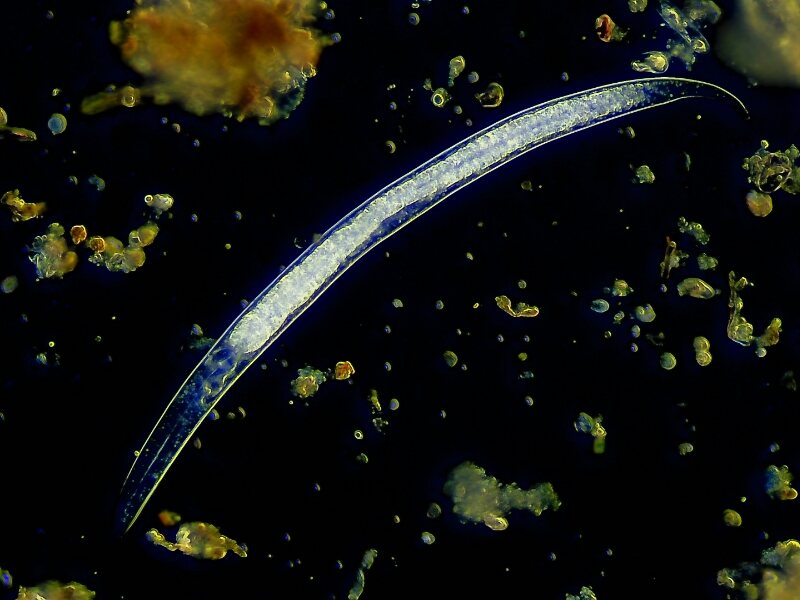
Most commercially available products are based on six types of beneficial nematodes from two main families, Steinernema and Heterorhabditis. Those six species are:
- Steinernema carpocapsae (Sc)
- Steinernema feltiae (Sf)
- Steinernema riobrave (Sr)
- Steinernema kraussei (Sk)
- Heterorhabditis bacteriophora (Hb)
- Heterorhabditis indica (Hi)
To choose between them, you must know the type of pest you plan to eliminate. Climate and organic certification are also important.
Insect Pest Type
Beneficial nematodes can be biological control agents for various pest populations. They work on:
- Fungus gnats
- Fly larvae
- Caterpillars
- Cutworms
- Armyworms
- Webworms
- Grubs
- Weevils
- Thrips
- Cockroaches
- Termites
- Ants and more
Much like certain medications treat certain diseases, each parasitic nematode type targets specific insect pests:
- S. feltiae and S. carpocapsae hunt to a depth of about three inches and target insects that lay their pupae and larvae closer to the soil surface, such as armyworms and fungus gnats.
- S. riobrave targets pests like weevils and mole crickets.
- The two species of the Heterorhabditis family go deeper into the soil hunting for insects such as white grubs.
You’ll find the specific pests each type targets on the product package. Most manufacturers have a detailed list on their websites. We also included one here with the most common garden pests and the type of nematodes you need to eliminate them.
| Type of Insect Pest | Nematode Species Needed for Control |
| Armyworms | S. carpocapsae, S. feltiae, S. riobrave |
| Ants | H. bacteriophora |
| Billbug | H. bacteriophora |
| Black Cutworm | S. carpocapsae, S. feltiae, S. riobrave |
| Black Vine Weevil | S. carpocapsae, S. riobrave, H. bacteriophora, S. kraussei |
| Bluegrass Weevil | S. carpocapsae |
| Cabbage Maggot | S. feltiae |
| Carrot Weevil | H. bacteriophora |
| Caterpillars | S. carpocapsae |
| Chafer (European, Masked) | S. riobrave, H. bacteriophora |
| Chinch bugs | S. carpocapsae, S. feltiae, S. glaseri, H. bacteriophora |
| Cockroaches | S. carpocapsae |
| Codling Moth | S. feltiae |
| Colorado Potato Beetle | H. bacteriophora |
| Cranberry Root Weevil | H. bacteriophora |
| Crane Flies | S. feltiae |
| Cucumber Beetle | S. carpocapsae, S. feltiae, H. bacteriophora |
| Cutworm | S. carpocapsae, S. riobrave |
| Fall Armyworm | S. carpocapsae |
| Flea (Larvae, Pupae) | S. carpocapsae |
| Flea Beetle | H. bacteriophora |
| Fly Larvae | S. carpocapsae |
| Fruit Flies | S. carpocapsae, S. feltiae |
| Fungus Gnats | S. feltiae, H. bacteriophora |
| Japanese Beetle | S. riobrave, H. bacteriophora |
| Leafminers | S. carpocapsae, S. feltiae, H. bacteriophora |
| May/June Beetles | H. bacteriophora, S. riobrave |
| Mint Flea Beetle | S. carpocapsae |
| Mole Crickets | S. carpocapsae, S. riobrave |
| Onion Maggot | S. feltiae |
| Raspberry Crown Borer | S. feltiae |
| Root Aphids | H. bacteriophora, S. feltiae |
| Root Maggots | S. feltiae |
| Root Weevils | S. riobrave |
| Shore Flies | S. feltiae |
| Sod Webworm | S. carpocapsae |
| Strawberry Root Weevil | S. carpocapsae, S. feltiae, S. riobrave |
| Sweet Potato Weevil | S. feltiae, H. bacteriophora |
| Queen Termites | H. bacteriophora |
| Belor-ground Termites | S. feltiae, S. riobrave |
| Worker or Soldier Termites | S. carpocapsae |
| Western Flower Thrips | S. feltiae |
| Ticks | S. feltiae, H. bacteriophora |
| Webworm | S. carpocapsae |
Source: Arbico Organics
Because it’s rare to deal with only one pest insect type, you will also find combinations of nematodes. For example, you can by:
- Mixes with Heterorhabditis bacteriophora and Steinernema carpocapsae for turf and pasture infestations.
- Products combining Steinernema carpocapsae, Steinernema feltiae, and Heterorhabditis bacteriophora for vegetables, trees, and ornamental plants.
The nematodes’ specific action makes it essential to correctly identify the pests you’re dealing with. If unsure, don’t hesitate to contact your local Cooperative Extension agent or local lawn care professionals who work in lawn pest control.
Organic-Certified
If you want organic-certified options, use the Organic Materials Review Institute (OMRI) website to check the products before buying. Some manufacturers use chemicals to keep the gel or nematode sponge moist. These options are not suitable for pest control in organically grown gardens.
Climate
Some nematodes are more resistant to heat and dry air than others. Manufacturers use them to develop better products for the south of the U.S. For example, Biologic has the Ecomask line based on a hybrid of S. carpocapsae, one of the varieties that can stay active for a few hours, even at 100°F.
Advantages and Disadvantages of Using Parasitic Nematodes
Beneficial nematodes have unique qualities and some important weak points to consider. Here’s what you put in the balance.
Advantages of Controlling Pests with Nematodes
✓ Nematodes can kill a wide range of insect pests.
✓ They work pretty fast. Infected pests die in 48 hours from infestation.
✓ Manufacturers grow nematodes in labs, making them inexpensive and accessible.
✓ They can tolerate most insecticides, herbicides, and fertilizers.
✓ Since no insect immunity exists to their bacteria, the efficacy does not decrease over time.
✓ Nematodes don’t hurt beneficial insects and are a safe alternative for the environment to chemical pesticides.
Disadvantages of Controlling Pests with Nematodes
✗ Timing must be precise to catch the pest insects during their soil-dwelling larval stage.
✗ Nematodes require proper storage and handling to keep them alive until application.
✗ Their efficiency depends highly on environmental conditions such as soil moisture and temperature.
✗ Because the pests don’t die when sprayed, as it happens when using harsh chemical pesticides, it’s hard to evaluate results. Improvements in plant health typically take about a month to see.
✗ Nematodes work more efficiently as a preventive tool and on small-scale infestations. With extensive infestations, they require multiple applications.
FAQ About Beneficial Nematodes
No, insect-parasitic nematodes do not hurt earthworms in your lawn and garden. They are also safe for humans, pets, plants, beneficial insects (bees, ladybugs, etc.), and even pests not part of their natural parasitic profile.
It depends on the type of microorganism. Nematodes in the Steinernema family mostly stay in the area where they land. They move through the water only to enter host insects in their proximity, though some seem capable of jumping. When working with Steinernema nematodes, ensure a thorough application in each area of your lawn or garden.
Heterorhabditis, on the other hand, travel around to find insect pests to feed on. If you miss some spots when spreading, they will get there by traveling through the water in the soil.
Nematodes resist most chemical insecticides but are sensitive to organophosphates, carbamates, and hydrogen dioxide. Before combining with other products, check their application instructions or the manufacturer’s website for compatible pesticides.
Choose a Safe Organic Pesticide
Beneficial nematodes are a safe and effective insecticide worth trying out and a gold mine if you’re aiming for organic gardening or eco-friendly lawn care. They won’t harm humans, pets, or pollinators and keep your plants protected without polluting the environment. It’s a good bet, and now you know where to buy them and how to use them.
Not a fan of spreading little “worms” on your lawn DIY? No worries. LawnStarter has the best professionals for the job. Find a lawn care pro in your area who specializes in lawn pest control and enjoy a clean, healthy, organic garden with the help of beneficial nematodes!
Main Photo Credit: CSIRO / Wikimedia Commons / CC BY 3.0
LawnStarter participates in the Amazon Services LLC Associates Program, an affiliate advertising program. LawnStarter may earn revenue from products promoted in this article.